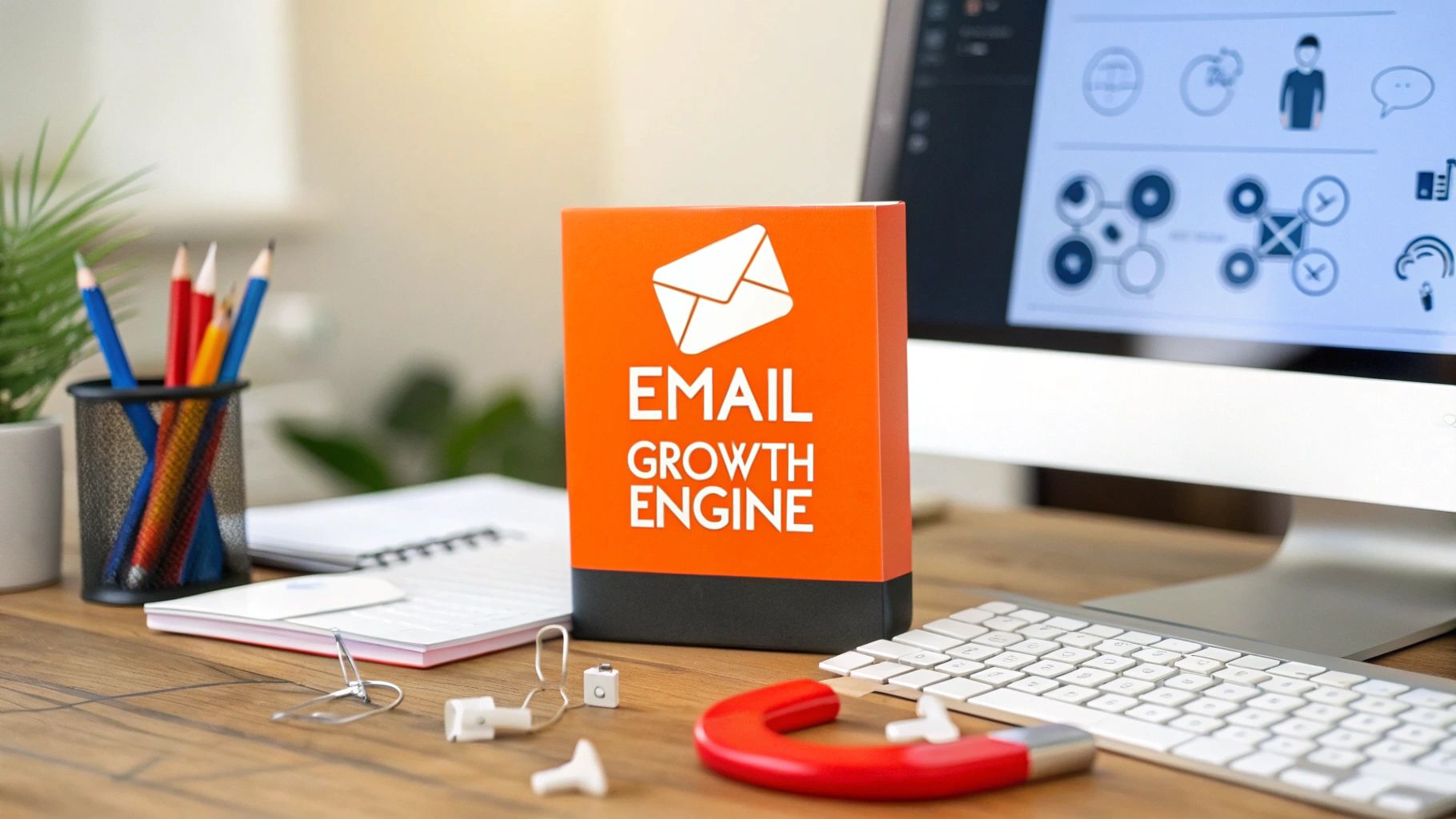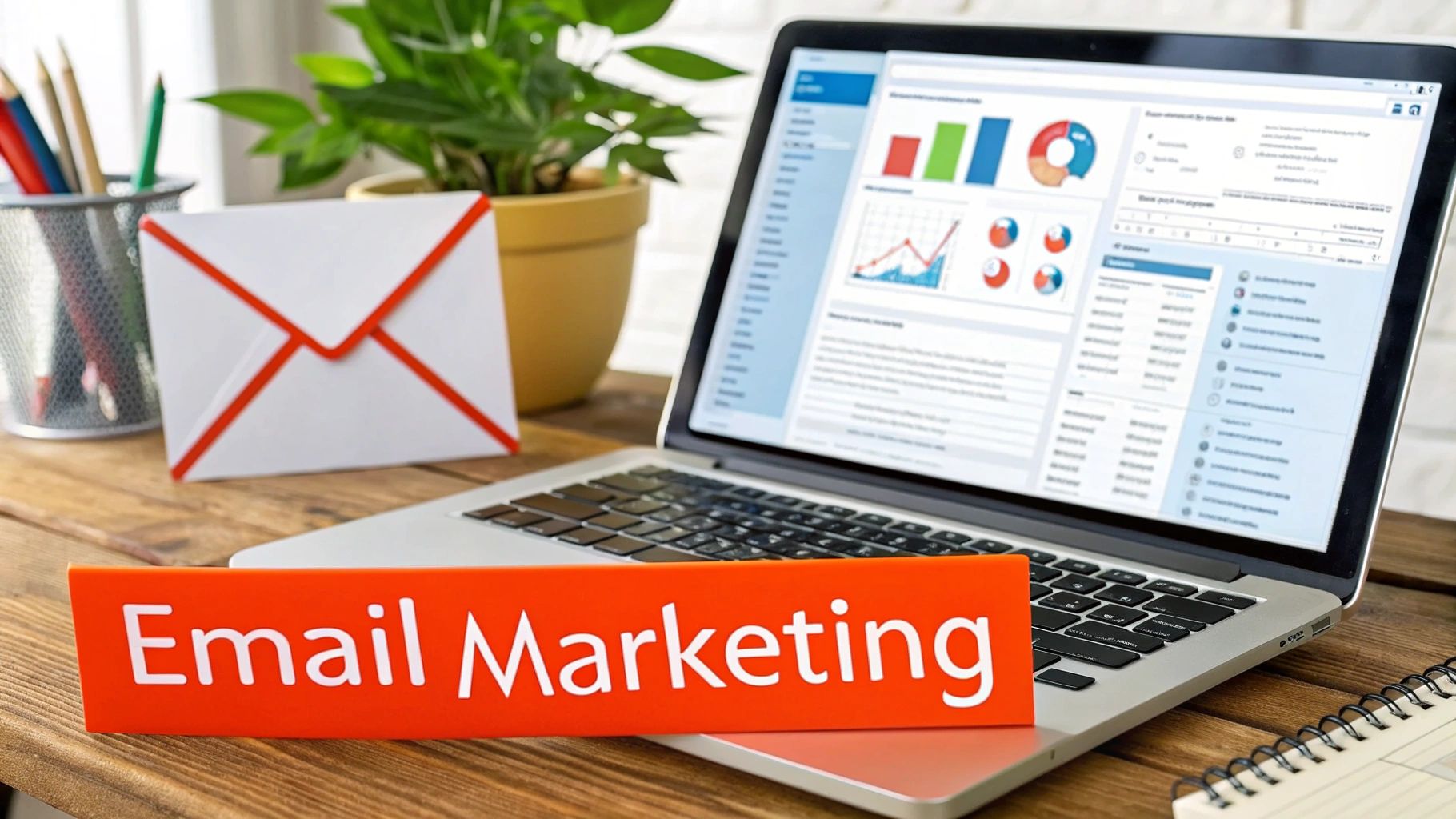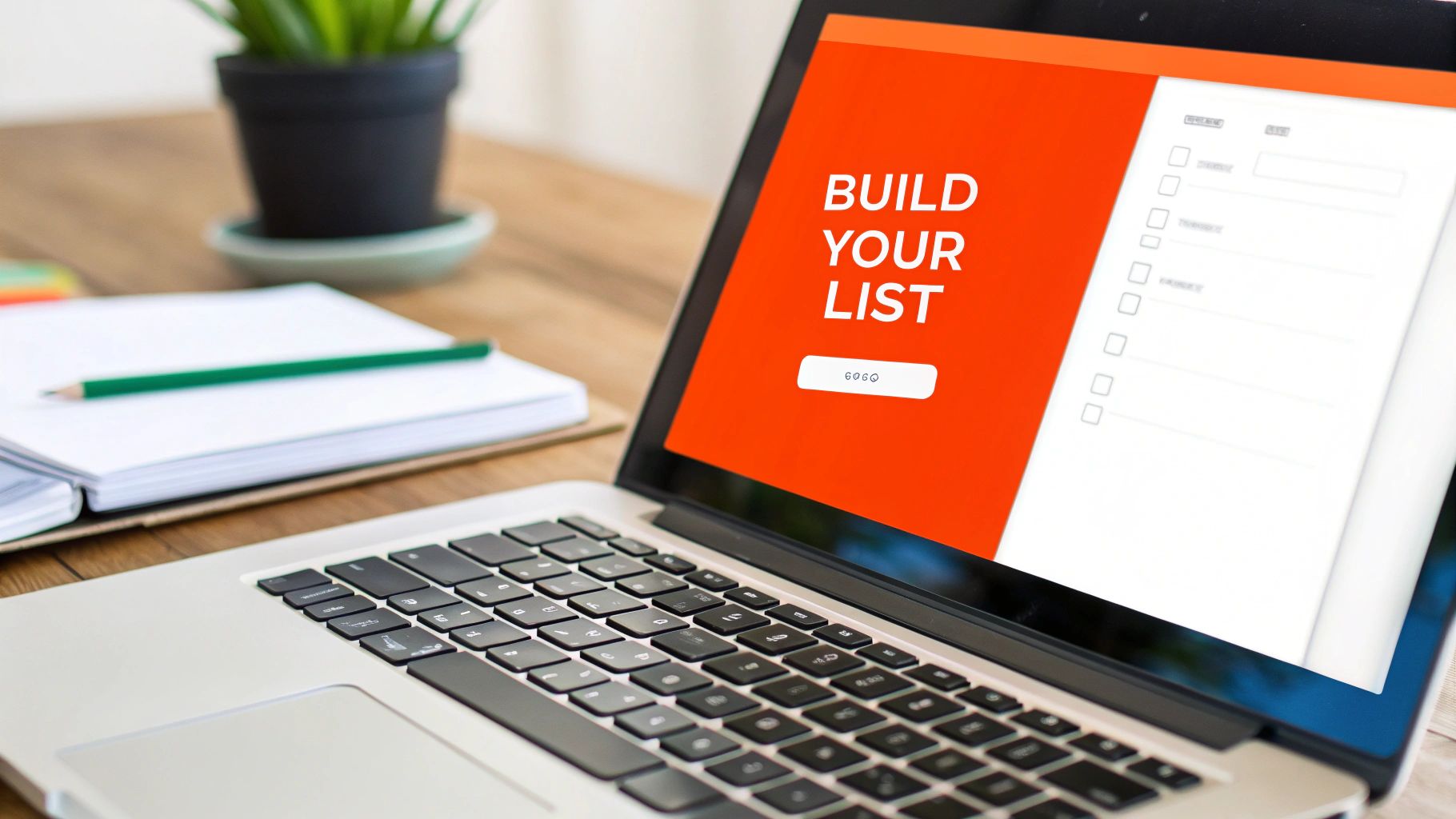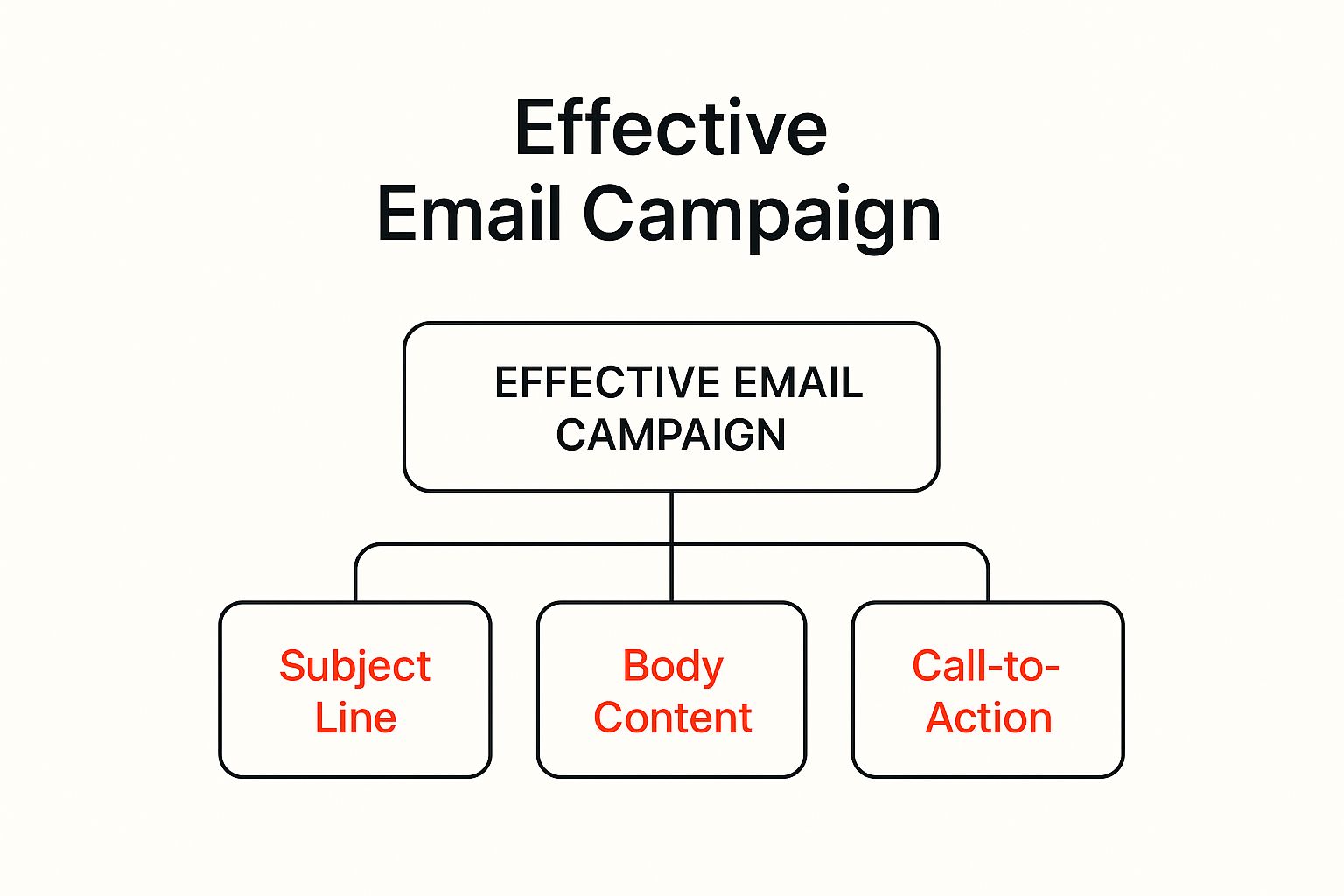
Email Marketing and Lead Generation Guide
Stop thinking about email marketing and lead generation as two separate items on your to-do list. They’re not. Think of them as two sides of the same coin—a single, powerful system that fuels your business growth. It's how you find people who are interested in what you do (leads) and then build a genuine relationship with them, right in their inbox.
Why Email and Leads Are Your Growth Engine

Let me be clear: your email list is one of the most valuable assets your business has. It’s not like social media, where you’re at the mercy of some mysterious algorithm deciding who sees your posts. Your email list is a direct line to your audience—one that you own and control. You're speaking to people who literally asked to hear from you.
That direct connection is what makes the partnership between email marketing and lead generation so incredibly effective. Lead generation is all about capturing the attention of potential customers. Email marketing is what you do next: you nurture that initial spark of interest, build trust, and guide them toward becoming a loyal customer.
The Power of an Owned Audience
An "owned audience" simply means you can talk to them directly without having to pay a middleman like a social media platform. Your email list is the ultimate example of this, and building it is fundamental to long-term, stable growth.
- Mind-Blowing ROI: The numbers don't lie. For every $1 you put into email marketing, you can expect an average return of $36. It’s one of the most cost-effective things you can do.
- Real Personalization: You can easily segment your list based on what people have shown interest in. For example, a travel company can send adventure-focused deals to subscribers who have clicked on hiking articles, while sending beach vacation packages to those who engaged with tropical content.
- Consistent Nurturing: Email allows you to set up automated sequences that educate your leads and build a relationship over time. A practical example is a "welcome series" for new subscribers that introduces your brand, shares your best content, and addresses common questions over the course of a week.
Here's the bottom line: You use smart lead generation tactics to attract interested people. Then, you use focused email marketing to turn that interest into real customer relationships and sales. It's a reliable, repeatable system for growth.
A Practical Playbook for Success
This guide is designed to be your playbook. We're getting straight to the actionable steps you need to build a quality list, write emails that get opened, and set up automations that work for you around the clock. If you want to dive deeper into the nuts and bolts, check out these proven email marketing for lead generation strategies.
Let's get started. It's time to change how you find and win over new customers.
How to Capture High-Quality Leads
When it comes to email marketing, forget the old-school approach of just trying to build the biggest list possible. The real win isn't in the numbers game; it's about quality. A small, fired-up list of 1,000 potential customers who actually want to hear from you is worth far more than a list of 100,000 who instantly delete your messages.
The goal is to attract people who are genuinely interested in what you do. We're turning casual website browsers into engaged subscribers who look forward to your next email.
This whole process kicks off when you offer something of real value in exchange for their email address. You have to give before you get. This "give" is what we call a lead magnet—a free, valuable resource that solves a specific problem for your ideal customer. A killer lead magnet is the hook that starts the entire relationship.
Design Irresistible Lead Magnets
Think of your lead magnet as a free sample of the incredible value you provide. It needs to be so helpful and on-point that a visitor would feel silly not to download it. Let's be honest, the old "subscribe to our newsletter" line just doesn't cut it anymore. People guard their inboxes fiercely, and they'll only let you in if the trade feels worth it.
Here are a few practical examples of high-value lead magnets that work:
- For a SaaS company: A checklist like "The 10-Point Pre-Launch Checklist for Your New Feature" is pure gold for their target audience of product managers.
- For a B2B consultant: An exclusive 15-minute video tutorial on "How to Fix the Top 3 LinkedIn Profile Mistakes" offers quick, actionable advice that professionals can use immediately.
- For an e-commerce brand: A PDF guide on "Choosing the Right Running Shoe" helps customers make a smart purchase, instantly positioning the brand as a trusted expert.
The secret sauce is matching the magnet to your visitor's intent. If someone's reading your blog post about social media, offering them a detailed content calendar template is a natural next step. Combining this type of content promotion with smart, organic outreach is a fantastic way for small businesses to build their brand. You can explore more ideas in these social media marketing tips for small business to see how different channels can feed into your lead generation.
Optimize Your Landing Pages and Forms
So, you've created an amazing lead magnet. Now what? You need a high-converting landing page and sign-up form to deliver it. A landing page has one job: convince the visitor to download your resource. That's it. Everything else on the page—like navigation bars or links to other posts—is a distraction that needs to go.
To make subscribing a complete no-brainer, your forms and pages should be built on simplicity and trust. Here's an actionable insight: Test your landing page headline. A simple A/B test changing "Free Ebook" to "Get the Guide That Helped 500+ Businesses Double Their Leads" can dramatically increase sign-ups by focusing on the outcome, not the format.
Your landing page isn't just a gate; it's the first handshake. Make it welcoming, clear, and trustworthy, and you’ll find people are far more willing to introduce themselves. A confusing or cluttered page is like a weak handshake—it creates instant doubt.
Keep your sign-up forms as simple as possible. Only ask for what you absolutely need, which is almost always just an email address. Every extra field you add is another reason for someone to bail. You can always gather more info later as you nurture the relationship.
Finally, build instant credibility by adding social proof. Displaying testimonials from happy customers, logos of companies you've worked with, or a simple line like, "Join 10,000+ professionals who use this template" gives visitors the confidence they need to sign up. This kind of validation taps into our natural tendency to trust what others are already doing and can make a huge difference in your conversion rates. For a deeper dive into these kinds of strategies, check out these B2B lead generation best practices.
Crafting Emails People Actually Want to Read

Getting someone to hand over their email address is just the starting line. The real work in email marketing and lead generation begins now. Landing in an inbox is one thing; earning a subscriber's attention in that crowded space is a whole different ballgame.
Forget the flashy templates and clever growth hacks for a moment. The secret to standing out is surprisingly simple: deliver genuine value and build a real connection, one email at a time. When you start focusing on your reader's world—their problems, their goals, their interests—your emails stop being a one-way broadcast and become a conversation that actually drives results.
The Anatomy of a High-Impact Email
Every single email you send has a job to do. To make sure it gets that job done, every piece of it, from the subject line to the final sign-off, has to work in harmony. Think of it like a short story, with each part designed to pull the reader to the next.
- Magnetic Subject Line: This is your first impression. Instead of a bland "Our New Software Update," try a practical, curiosity-driven line like, "A small tweak to your workflow, a big jump in productivity."
- Intriguing Preview Text: This snippet supports the subject line. For the example above, the preview text could be: "It takes 5 minutes to set up and saves hours. Here's how..."
- Persuasive Body Copy: Get to the point quickly. Use bullet points to break up text and bold key phrases. For instance, clearly state the benefit: "Actionable Insight: Implement this change before your next team meeting to see an immediate improvement."
- A Single, Clear CTA: What, exactly, do you want the reader to do next? Don't make them think. A specific, powerful call-to-action like "Watch the 3-Minute Demo" or "Grab Your Free Template" will always outperform a vague "Learn More."
Moving Beyond Basic Personalization
Using a subscriber's first name is table stakes these days. Real personalization runs much deeper. It’s about using what you know about a person to send them content that feels like it was written just for them. This is where your lead generation efforts truly pay off, giving you the raw material for highly relevant, targeted messages.
Let's say you run a B2B SaaS company. A new lead downloads your guide on "improving team collaboration." That's a huge clue about what's on their mind. Instead of just dumping them into a generic welcome sequence, you can send a much smarter follow-up.
An email that speaks to a subscriber's known interests is no longer an interruption; it's a solution arriving at the perfect time. This shift from generic to specific is the key to building trust and driving action.
For that specific lead, your first email could be titled: "3 Collaboration Mistakes Most Teams Make (And How to Fix Them)." Right away, you’re showing them you understand their world and have valuable advice to offer. This isn't just marketing; it's building authority and a genuine relationship.
Real-World Examples: B2B vs. B2C
The core principles of great email writing are universal, but how you apply them can look very different. Let's break down how B2B and B2C brands can use storytelling to make a connection.
B2B Example: A Project Management Tool
- Generic Email: "Our software helps you manage tasks."
- Story-Driven Email: "Sarah, a project manager at a growing startup, was drowning in spreadsheets. Her team kept missing deadlines, and communication was a total mess. We showed her how to centralize everything in one place. Two weeks later, her team shipped a major project ahead of schedule."
B2C Example: A Skincare Brand
- Generic Email: "Buy our new face serum, now 20% off."
- Story-Driven Email: "Meet Emily. She struggled for years with dull, tired-looking skin and felt self-conscious. After trying countless products, she discovered our Vitamin C serum. Read her story to see how she got her glow back in just 30 days."
In both scenarios, the story-driven email is infinitely more powerful. It creates an emotional hook, makes the benefits feel real, and helps the reader picture themselves achieving the same success. This is how you write emails that don’t just get read—they get remembered.
Email's staying power is undeniable, with an estimated 4.6 billion global users expected by 2025. In the B2B world specifically, 70% of marketers used email newsletters in 2024, proving it remains a central pillar for nurturing leads. For a deeper dive, you can explore the latest email marketing statistics for 2025.
How Segmentation and Personalization Actually Grow Your Business
Sending the same email to your entire list is like trying to have a meaningful conversation by shouting into a packed stadium. It's just noise. The real magic in email marketing happens when you stop broadcasting and start connecting, and that’s where segmentation and personalization come in.
Think of it this way: your email list isn't one giant, faceless crowd. It's a collection of individuals with different needs, interests, and histories with your brand. Segmentation is the art of grouping these people into smaller, more relevant buckets. Personalization is crafting messages that speak directly to what each bucket cares about.
This isn't just about being friendly; it's about being profitable. For every $1 you put into email marketing, the average return is a staggering $36. A huge piece of that ROI comes from this kind of targeted approach. In fact, segmented campaigns see 30% higher open rates and 50% more click-throughs than generic emails. You’re not just sending emails; you’re solving specific problems for specific people.
The Smart Way to Segment Your Audience
You don't need a PhD in data science to get started. Effective segmentation often comes down to a few practical, common-sense categories. Start here, and you'll already be way ahead of the game.
Demographic Segmentation: This is the most straightforward approach. Actionable example: A financial services firm could create a segment of subscribers aged 25-35 located in major cities and send them content about "First-Time Home Buying Tips."
Behavioral Segmentation: This is where things get really powerful. You segment based on what people do. Actionable example: If a user on your e-commerce site viewed a specific product three times but didn't buy, you can automatically send them an email with customer reviews for that exact product.
Interest-Based Segmentation: This groups subscribers based on the content or products they've engaged with. Actionable example: A food blog can tag subscribers who click on vegan recipes and create a "Vegan Enthusiasts" segment, ensuring they only receive plant-based content in the future.
The infographic below really drives home how these targeted elements fit into the bigger picture of a successful email campaign.

When you nail segmentation, every single one of these components—from the subject line to the final call to action—becomes sharper and more effective.
Effective Segmentation Strategies
To make this crystal clear, here's a breakdown of how different segmentation types can be used to create highly relevant campaigns.
| Segmentation Type | What It Is | Example Campaign Idea |
|---|---|---|
| Demographic | Grouping by static traits like age, location, job title, or company size. | A clothing brand sends a "Back to School" promotion specifically to subscribers in college towns in August. |
| Behavioral | Grouping by actions taken, such as purchase history, email opens, or website activity. | An e-commerce site emails a "We Miss You" discount code to customers who haven't purchased in 90 days. |
| Psychographic | Grouping by lifestyle, values, or interests gathered from surveys or on-site behavior. | A travel company sends a campaign for adventure travel packages to users who have clicked on hiking and kayaking content. |
| Lead Score | Grouping by a numerical score that indicates sales-readiness based on engagement. | A B2B company triggers a demo request email to leads whose score crosses a certain threshold, indicating they are "hot." |
These examples show just how specific—and powerful—your messaging can become. You move from a one-size-fits-all approach to a strategy that feels tailor-made for every recipient.
Let's See It in Action
Imagine an online store that sells running gear. Instead of blasting their whole list with a generic "20% Off" coupon, they can do something much smarter.
Sending the right message to the right person at the right time isn't just a marketing cliche—it's the formula for building relationships that drive revenue. Segmentation makes this formula achievable.
Segment 1: The Cart Abandoner
A visitor added a pair of expensive trail running shoes to their cart but left the site without buying.
- The Email: About an hour later, they get an automated email with the subject: "Still thinking about those trail shoes?" Inside is a picture of the exact shoes, a great review from another trail runner, and a clear "Complete Your Order" button. It’s helpful, not pushy.
Segment 2: The Loyal Repeat Customer
This person has bought from the store five times in the past year, always focusing on gear for marathons.
- The Email: They get an exclusive message: "A VIP Offer for Our Top Runners." The email thanks them for being a loyal customer and gives them early access to a new line of hydration packs before anyone else. It's a reward that makes them feel valued.
See the difference? One email is a timely nudge to solve a moment of hesitation, while the other deepens an already strong customer relationship. Both are infinitely more powerful than a one-size-fits-all sale. For SaaS businesses wanting to dive deeper into these kinds of tactics, check out dedicated communities where you can find valuable insights in subreddits dedicated to SaaS email marketing. This is how you unlock real, sustainable growth.
Optimizing for Mobile and Measuring What Matters

You can craft the most brilliant email strategy in the world, but it all falls apart if your subscribers can't read it or if you have no idea whether it's actually working. Two things can make or break your entire email marketing and lead generation effort: how your emails look on a phone and how you analyze the data.
Getting these right isn’t some "nice-to-have" detail; it's absolutely fundamental. Think about it: the most persuasive copy means nothing if the text is tiny and the button is impossible to tap on a phone. You've just lost a lead. In the same way, celebrating high open rates without understanding your click-throughs and conversions is like cheering for a car spinning its wheels—it looks busy, but it isn’t going anywhere.
Designing for the Mobile-First World
How do you check your own email? Chances are, it's on your phone while you're waiting for coffee or during a quick break. Your audience is no different. By 2025, mobile is expected to account for a staggering 41.6% of all email opens across the globe. This isn't just a trend; it's the new standard.
Designing for mobile can boost your unique clicks by 15%. And yet, around 20% of campaigns are still not built for small screens. This mistake is costly—nearly 42.3% of users will just delete an email that doesn’t display correctly on their device. You can dig into more stats on how mobile design impacts email campaigns from Porch Group Media.
Here are some practical actions to nail the mobile experience every time:
- Stick to a Single-Column Layout: This is the gold standard for a reason. It neatly stacks your content, making it a breeze to scroll through without any of that frustrating pinching and zooming.
- Use Legible Fonts and Breathing Room: Choose web-safe fonts and set your body text to at least 16px. Just as important is white space—use it generously to keep your design from feeling cluttered.
- Make Your CTAs Thumb-Friendly: Your call-to-action buttons need to be big, bold, and easy to tap. Apple’s best practice recommendation is a minimum touch target of 44x44 pixels, which is a great starting point. Actionable tip: Always send a test email to your own phone and physically try to tap the buttons and links. If it feels awkward for you, it will be for your subscribers too.
Measuring What Truly Matters in Email Marketing
Once your design is solid, it's time to measure the right things. Too many marketers get hung up on "vanity metrics" like open rates. Real growth, however, is found in the numbers that signal action and genuine interest.
Don't just count who opened your email; measure who acted because of it. An open is a sign of curiosity, but a click or conversion is a sign of genuine interest—and that’s what fuels lead generation.
To get a true picture of your email strategy's health, keep a close eye on these core metrics and what they tell you:
Click-Through Rate (CTR): This is the percentage of people who actually clicked on a link in your email. A high open rate but a low CTR is a classic sign that your subject line made a promise your email content didn't keep. Actionable Insight: If your CTR is low, try making your call-to-action more direct or ensure the link is placed prominently "above the fold."
Conversion Rate: This tracks how many people took the action you wanted them to—downloading your guide, signing up for a webinar, or buying a product. This is the bottom-line metric for lead generation.
List Growth Rate: This shows you how fast your email list is expanding. A list that's consistently growing is a clear sign that your lead capture methods are hitting the mark.
Unsubscribe Rate: No one likes seeing people leave, but this number tells a story. A low unsubscribe rate (usually below 0.5%) is a good indicator that your content is resonating with the right audience.
When you focus on these metrics, you stop guessing and start making informed decisions. A low conversion rate might mean your call-to-action is confusing. A poor CTR could point to a weak offer. This data-driven approach is how you turn email marketing into a reliable, predictable engine for generating leads.
Answering Your Top Email & Lead Generation Questions
When you're trying to master email marketing and lead generation, a few common questions always seem to pop up. Getting these fundamentals right can completely change your results, moving you from a place of confusion to having a clear, effective strategy.
Let’s dig into some of the most frequent questions I hear and give you some practical, no-fluff answers. Think of this as a quick way to build confidence and sidestep the usual mistakes as you grow your list.
How Often Should I Email My List?
Everyone wants a magic number, but the truth is, it doesn't exist. That said, a great starting point for most businesses is once a week. What matters most isn't the exact frequency but your consistency and the actual value you deliver with every send.
It's always better to send one genuinely useful email a week than three bland messages that people start ignoring. You need to keep a close eye on your engagement metrics. If you see your unsubscribe rate ticking up or your open rates taking a dive, that’s a clear signal you might be emailing too often for your audience.
The sweet spot is a balance between staying on your audience's radar and respecting their inbox. Don't guess—test different schedules and let your data, especially open, click, and unsubscribe rates, tell you what's working. A practical test: Try sending twice a week to a small segment of your most engaged users for a month and compare their metrics to the rest of your list.
What Is the Difference Between a Lead and a Subscriber?
This is a really important distinction that often trips people up. A subscriber is simply anyone who has opted-in to get your emails, usually from a general newsletter form on your site. They’ve raised their hand to show some initial interest, but that’s about it.
A lead, however, is a subscriber who has taken an extra step, showing a much higher level of interest. Maybe they downloaded a specific guide, a checklist, or a case study. That action tells you they're likely looking to solve a problem that your business can help with. For example, someone who subscribes to a blog is a subscriber. When that same person downloads an ebook titled "The Ultimate Guide to B2B Lead Generation," they become a qualified lead for a marketing agency.
How Can I Keep My Emails Out of the Spam Folder?
Email deliverability is everything. If your emails don't land in the inbox, nothing else matters. Your main goal is to prove to services like Gmail and Outlook that you're a legitimate sender whose emails people actually want.
Here are the non-negotiable best practices:
- Always get explicit permission. The best way to do this is with a double opt-in, where a new subscriber has to click a link in a confirmation email. This proves they really want to hear from you.
- Keep a consistent sending schedule. Sending emails at predictable times helps build a positive reputation with email providers.
- Avoid spam trigger words and formatting. Stay away from gimmicky subject lines filled with exclamation points, all caps, or cliché words like "free," "guarantee," or "act now." A practical example: Instead of "FREE EBOOK - ACT NOW!", try "Your copy of the ebook is inside."
- Clean your email list regularly. Every few months, go through and remove inactive subscribers who haven't opened your emails. This keeps your engagement rates high, which is a massive quality signal to email providers.
If you want to dive deeper, joining online communities is a fantastic way to learn what's working for others in real-time. You can find some incredibly valuable discussions by checking out marketing-focused subreddits, where pros share their latest tips and tactics.
Ready to turn Reddit's engaged communities into a reliable source of traffic and leads? Reddit Agency specializes in crafting authentic marketing strategies that resonate with savvy audiences. We'll help you build your brand, generate qualified leads, and drive real business growth.